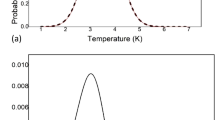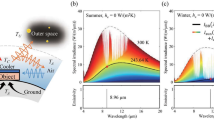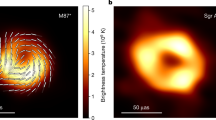Abstract
After studying the normalized Planck equation in depth, a brand-new type of spectrum curves of blackbody thermal radiation is given. Two important parameters of the new type curves, namely relative width RWη and symmetric factor RSFη, are defined. The paper points out that the experimental verification of the parameters has three significant applications: (1) Giving a method to measure temperature by detecting the radiation wavelength. (2) Determining the blackbody grade. (3) The temperature obtained from the law of the blackbody thermal radiation can be used as a criterion.
Similar content being viewed by others
Introduction
It is well known that, over the past hundred years, the theoretical basis of the blackbody thermal radiation is expressed in the form of Planck’s law, given by1,2,3,4

where C1 = 3.7415 × 10−4 W·μm2, C2 = 1.4388 × 10−4 μm2·K. eb(λ, T) is the monochromatic radiant emittance of the blackbody at the temperature T(K) and radiation wavelength λ(μm). For a given temperature, the eb(λ, T) and wavelength λ are related by the traditional spectrum curve of the blackbody thermal radiation5, as shown in Fig. 1. When the first derivative of function eb(λ, T) with respect to λ is equal to 0, the relationship of the temperature with the peak wavelength λm of the curves in Fig. 1 results, which is the famous Wien displacement law6

Under the development of the remote sensing7, night vision8, and thermal radiation thermometry technology9, many further studies on the blackbody thermal radiation have been carried out. For examples, by studying the inflection point feature along the both sides of the curves in Fig. 1, the lightwave equation of the inflection point was obtained as

then the relationship of the wavelength at the left inflection point λli and right inflection point λri with temperature T was derived from (3)10


In order to find the wavelength domain of Eq. (1), ref. 11 proposed a normalized Planck’s equation

where the normalization coefficient η is defined by the following equation

Obviously, η ranges from 0 to 1, inclusive. And the value of x in Eq. (6) is given by

When η trends to zero, the variation of x or λ in Eq. (8) with temperature T was studied in reference 11. For η equal to 10−6, the conclusion of the reference is that the domain of the wavelength λ is between 88 and 1051(μm), when temperature between 200 and 6000(K).
Based on these studies above, the relationships between λ and η are investigated in this paper. And from the obtained relationships in this paper, a brand-new type of spectrum curves of the blackbody thermal radiation results, which is much clearer than that was. Then the relative width and symmetric factor of the spectrum curves are defined. Finally, a wavelength thermometry is presented, and the significant applications of the results obtained in this paper are shown as well.
Results
Normalized spectrum curve of the blackbody thermal radiation
For different values of η, Eq. (6) is a series of transcendental equations without analytical solutions, thus a brand-new normalized spectrum curve of the blackbody thermal radiation can be obtained from their numerical solutions. In order to numerically solve (6), it is necessary to determine its roots distribution. Programming to find out the roots of Eq. (6), Fig. 2 shows that, for a given η, the curve has two intersection points with the x-axis, which indicates that the transcendental Eq. (6) has two roots, denoted as xηs and xηl (xηl < xηs). In accordance with Eq. (8), the two roots of xηs and xηl can lead to the wavelengths of ληs and ληl, respectively, which locate on the left and right side of the spectrum curve with the corresponding value of η.
The curve of the left side of Eq. (6), when η = 0.8, 0.85, and 0.9.
Programming to numerically solve (6), the relationship of η with its corresponding xηs and xηl results, as shown in Table 1. If necessary, any magnitude of xηs or xηl can be obtained by solving (6) based on the different value of η. RWηt and RSFηt in Table 1 are the theoretical results of the relative width and symmetric factor of the spectrum curves obtained from Eqs (14) and (15).
For η = 1, the values of xηl are equal to xηs, which are both recorded as xm. Substituting xηs, xηl and xm of each η and the previous value of C2 into Eq. (8) can produce the following equations



Then, Table 1 can lead to a brand-new type of spectrum curves of the blackbody thermal radiation, as shown in Fig. 3.
For a given Kelvin temperature T and under the condition of η equal to 1 in Table 1, the substitution of the xm into (11) can lead to the same peak wavelength λm of Eq. (2). The short wave edge ληs and long wave edge ληl, sitting on the both sides of the curve’s peak, can be obtained from Eqs. (9) and (10), then the relationship at this temperature of η with λ results. For example, when T = 1000 K, substituting any values of xηs and xηl, which correspond to a certain value of η in Table 1, into Eqs (9) and (10) can obtain the values of ληs and ληl in Table 2. Then, using Table 2 can yield the η-λ curve 4 in Fig. 3(a). Similarly, other η-λ curves in Fig. 3 at different temperature can be obtained as well, which are the normalized spectrum curve of the blackbody thermal radiation presented in this paper. It should be noted that it will spend considerable software resources and time to solve Eq. (6), using the unknown of η in Table 1 to get a curve. Therefore, the data in Table 1 is already enough to be used in general conditions, and may also be used as a manual text to plot the other spectrum curves. In addition, the monochromatic radiant emittance of ληs and ληl at any temperature can be obtained from the right side of Eq. (7), when necessary.
Feature description and application analysis on the spectrum curve
In order to accurately describe the characteristics of the normalized spectrum curve of the blackbody thermal radiation, the actually measured wavelength ληs, λm and ληl can give a definition for the curve of the relative width RWη and symmetric factor RSFη as


On the other hand, substituting the wavelength of Eqs (9) to (11), into (12) and (13) respectively, RWη and RSFη can be theoretically defined as follows


The RWηt and RSFηt of Table 1 are the theoretical results produced from (14) and (15), with the corresponding xηs, xηl, and xm. Obviously, RWηe and RSFηe are closely associated with η. But it is usually more concerned with RW0.5e and RSF0.5e, i.e., η = 0.5.
For any of the RWη or RSFη, the Eqs (12) and (13) are the experimental results, and Eqs (14) and (15) are the theoretical. Thus, if the experiment systems are reliable and the experimental results are consistent with the theoretical values, it will prove that the object tested in the experiment is a blackbody. In addition, the following equations can be derived from Eqs (9) to (11),



The Eqs (16) to (18), show that the true temperature of the tested object can be detected by measuring the wavelength of  ηs,
ηs,  ηl, and λm, namely, which provides a thermometry based on the measurement of the radiation wavelength.
ηl, and λm, namely, which provides a thermometry based on the measurement of the radiation wavelength.
Discussion
Only the local spectrum characteristics of the blackbody thermal radiation have been studied in refs 6, 10, and 11 based on the traditional spectrum curve. In this paper, its global characteristics are studied based on the brand-new type of spectrum curves of blackbody thermal radiation as shown in Fig. 3. The results obtained in this paper have three important significances.
First, it provides a novel method to verify blackbody and its grade. From the Eqs (12) to (15), given by the experimental and theoretical results, two errors of a and b can be defined as follows


Then, using a and b can give an exact definition to the blackbody. When a and b are both equal to 1, it represents an ideal blackbody. When a and b are very close to 1, such as 0.9, 0.99, 0.999 and so on, it can define different grades of the actual blackbody.
Second, using an actual high-level blackbody as the experimental subject and applying a high-precision spectrometer to detect the radiation wavelength, it can be seen from Eqs (16) to (18), that, at a constant temperature, the actual temperature of a blackbody can be determined by measuring three wavelength values: the peak wavelength and two wavelengths corresponding to a suitable η. Therefore, the temperatures calculated from the three wavelengths have a cross-calibration function, which can fully verify the credibility of the measured temperature. As long as the errors between them are small enough, the temperature obtained from Eqs (16) to (18), can be used as a criterion.
Table 1, Fig. 3 and these two points above are the most important conclusions of this paper, which are enlightening and helpful for further researches on the blackbody thermal radiation. Unfortunately, there are no equipments for authors to do relevant experiments. So we can only provide the theoretical results here to share with readers.
Finally, based on the researches available on the blackbody thermal radiation, it must be noted for the earth’s thermal radiation that the microwave, which has been detected by the passive microwave remote sensing technology12, cannot be predicted by Planck’s law in Eq. (1), even at the nearly lowest temperature of the Earth’s surface11. To solve this problem for describing the characteristics of the gray body thermal radiation, authors believe, it maybe go one step further and deeply study Kirchhoff’s law13, and that will be our next research topic.
Additional Information
How to cite this article: Yang, X. and Wei, B. Exact research on the theory of the blackbody thermal radiation. Sci. Rep. 6, 37214; doi: 10.1038/srep37214 (2016).
Publisher's note: Springer Nature remains neutral with regard to jurisdictional claims in published maps and institutional affiliations.
References
M. Planck . The Theory of Heat Radiation 2nd ed (Blakiston’s Son & Co, 1914).
An, Y. Y., Liu, J. F., Li, Q. H. & Feng, J. J. Photoelectronic Technique (Electronic Industry Press, 2002).
Wang, J. X. et al. Photon energy upconversion through thermal radiation with the power efficiency reaching 16%. Nature Communication 5, 1–8 (2014).
Kasimir, B., Tero, S. & Ari, T. F. Blackbody aperture radiation: Effect of cavity wall. Physical Review A, 91, 063805 (2015).
Chen, S. Z. & Jiang, Z. Y. General Physics 5nd ed (Higher Education Press, 1998).
Wang, S. J. & Gu, M. University Physics 2nd ed (Tongji university press, 2003).
D. Rocchini . Earth Observation for Ecosystems Monitoring in Space and Time: A Special Issue in Remote Sensing. Remote Sensing 7, 8102–8106 (2015).
Chrzanowski, K. Review of night vision technology. Opto-Electronics Review 21, 153–181 (2013).
Yamada, Y. & Ishii, J. Toward Reliable Industrial Radiation Thermometry. International Journal of Thermophysics 36, 1699–1712 (2015).
Chen, G. S., Lu, W. Q., Cai, R. H. & Ding, X. H. The Light Wavelength Equation of Inflexion in Planck Function. Guangxi Sciences 11, 175–176 (2004).
Chen, G. S., LU, W. Q., Cai, R. H. & Ding, X. H. Research of Definitive Range of the Light Wavelength on heat Radiation for Blackbody. College Physics 23, 58–60 (2004).
Fawwaz, T. U., Richard, K. M. & Adrian, K. F. Microwave Remote Sensing: Active and Passive vol. 1–2 (Artech House Publishers, 1982, 1983).
Miller F. P. Kirchhoff’s Law of Thermal Radiation (VDM Verlag Dr. Mueller e. K., 2010).
Acknowledgements
We are greatly indebted to Prof. Lu Wen-quan for his selfless help. Special thanks are expressed to Dr. KONG Qing-lin for his advices on English writing. This work is financially supported by the National Natural Science Foundation of China (grant nos 61231003, 61401344, 61571348). We also acknowledge the support from the Radio Research Institute of Xidian University.
Author information
Authors and Affiliations
Contributions
Xin Yang undertook the specific work, Bing Wei supervised the work. All authors reviewed and edited the final manuscript.
Ethics declarations
Competing interests
The authors declare no competing financial interests.
Rights and permissions
This work is licensed under a Creative Commons Attribution 4.0 International License. The images or other third party material in this article are included in the article’s Creative Commons license, unless indicated otherwise in the credit line; if the material is not included under the Creative Commons license, users will need to obtain permission from the license holder to reproduce the material. To view a copy of this license, visit http://creativecommons.org/licenses/by/4.0/
About this article
Cite this article
Yang, X., Wei, B. Exact research on the theory of the blackbody thermal radiation. Sci Rep 6, 37214 (2016). https://doi.org/10.1038/srep37214
Received:
Accepted:
Published:
DOI: https://doi.org/10.1038/srep37214
Comments
By submitting a comment you agree to abide by our Terms and Community Guidelines. If you find something abusive or that does not comply with our terms or guidelines please flag it as inappropriate.






